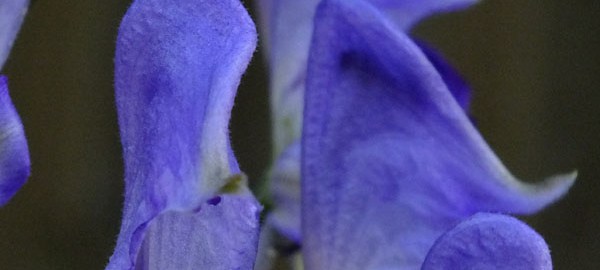A chic hat
Update: ID as Aconitum variegatum subsp. paniculatum
All Aconitum species are wearing cool hats but this one in particular with the hood on one side looks very chic. Growing Aconitum from seeds that are not properly identified is quite a pain, but worth the trouble.
All monkshoods are equally beautiful and deadly, with spikes of violet, dark blue, yellow or white hood-shaped, complicated flowers that one needs to know the terminology in order to ‘read’ their characters. Species are usually described on the basis of root and flower morphology.
After lots of searches, pictures, dissections… this one was narrowed down to Aconitum variegatum subsp. paniculatum (syn. Aconitum degenii) or A. variegatum subsp. variegatum. We’ll know for sure in late fall after I’ll dig it up and see the tuber shape; and maybe I’ll have a seed or two but glad to hear other opinions…
Before being praised as a garden plant, Aconitum was considered (and still is) “the king of the poisons” (Europe) or “the king of medicines” (Tibet and China), depending on where it grew, but this is a good subject for wintertime storytelling…
It is a good idea to wear gloves when doing anything that involves touching an Aconitum. It contains highly active and toxic alkaloids.











I’ve never grown Aconitum before this year, but now I have one that’s just about ready to bloom. I’m really looking forward to seeing the flowers. I seem to remember that someone died in Ontario a few years ago from ingesting Monkshood.
What species it’s yours? They are so great for late summer and fall display, my A. fischeri is still in bud – might flower beginning of October.I have read that indeed the only case
reported of someone dying from Aconitum it is of a young Canadian man who chew on some leaves while hiking! One of those things…I wouldn’t worry unless young children around the house.
Mine is Aconitum carmichaelii fischeri. It’s going to bloom any day now! No young children here, except when the grandchildren visit. The older ones are already familiar with the botanical names of many plants, thanks to my daughter’s influence, and the younger ones are closely supervised. It’s funny that Aconitum comes with so many warnings when there are plenty of other poisonous plants in the garden.
It will be a beauty! You’re very right, and there are so few reports about accidents; Aconitum is a ‘classic’ poisonous plant, maybe because its effects have been known for a long, long time and it acts fast, on the nervous system.